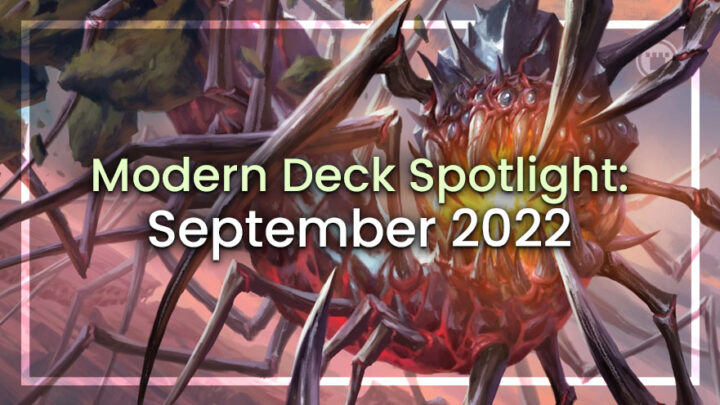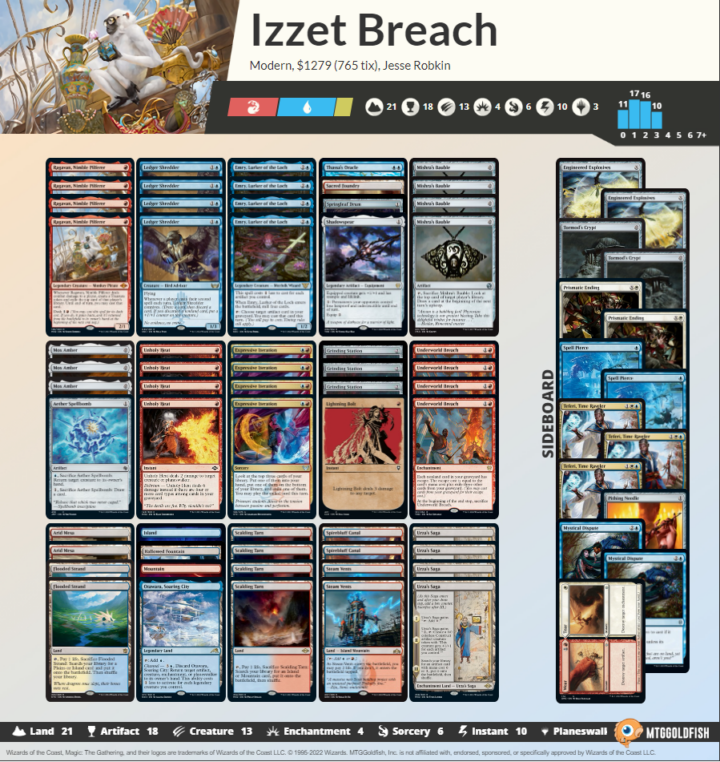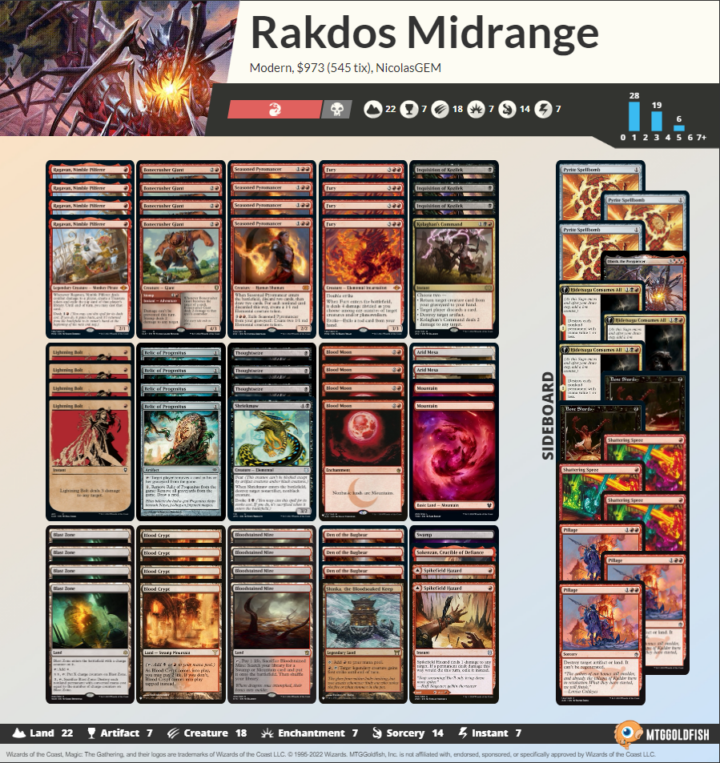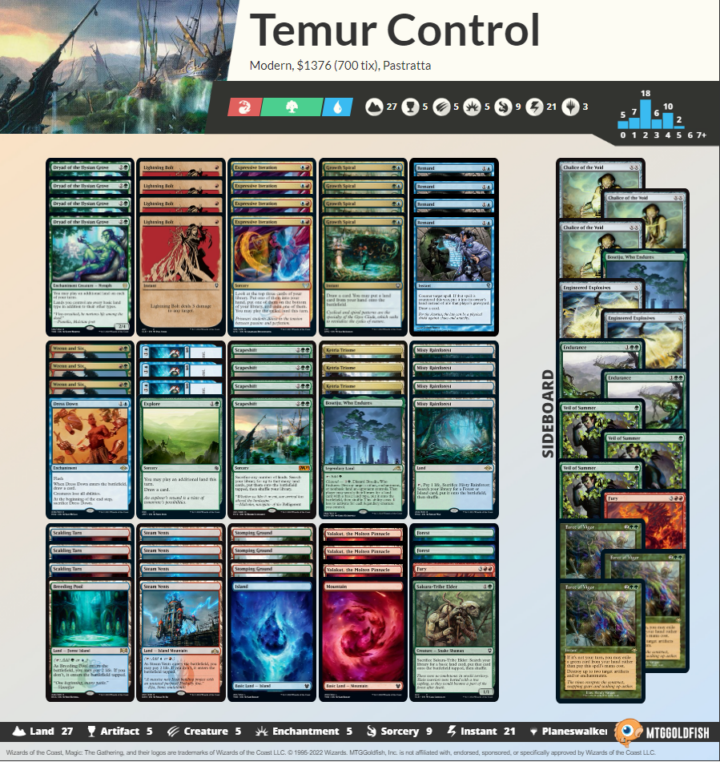I wanted to try something different from my normal longer, more in-depth pieces focusing on one deck, so welcome to Card Kingdom’s first Modern Deck Spotlight. The goal of this series is to introduce new or interesting decks from the past weekend of high level play, just to help familiarize players with decks they may not have seen before.
Last weekend brought us the NRG event in St. Louis, an RCQ on Magic Online and the normal MTGO challenge, which means there are plenty of results to pull from. Let’s step into the spotlight and talk about the coolest decks from last weekend!
Jeskai Breach
Jeskai Breach has been floating around for a bit, and Jesse Robkin already wrote about the deck for TCGPlayer. However, it has continued to fly just under many players’ radar. But recently, Ross Merriam and Corey Baumeister both won RCQs with the deck, and Jesse Robkin made the finals of both the team and Modern events in St. Louis with Jeskai Breach.
Jeskai Breach plays many of the powerful Izzet tempo cards: Ledger Shredder, Ragavan, Nimble Pilferer, Lightning Bolt, Unholy Heat and Expressive Iteration. Combine those cards with Urza’s Saga and you get a completely reasonable Izzet tempo deck.
The thing that sets Jeskai Breach apart from a deck like Izzet Murktide is it also incorporates a combo kill. Underworld Breach + Grinding Station + a zero-mana artifact will allow you to mill your entire deck to win with Thassa’s Oracle. Lightning Bolt can also be used to win instead of Thassa’s Oracle should the artifact be Mox Amber with a Ragavan in play.
Forcing opponents to respect the combo makes them vulnerable to the tempo plan and respecting the tempo plan leaves them vulnerable to the combo, and Jeskai Breach can switch between the two plans with little effort. If you were a fan of Splinter Twin, Jeskai Breach plays out surprisingly similarly and is worth a try.
Rakdos Obosh
Obosh, the Preypiercer isn’t the companion I expect my opponent to present to start a game, but it did take down the MTGO RCQ in the hands of NicolasGEM.
You may be familiar with Rakdos Scam, which has been making the rounds lately. The deck is centered around Fury and Grief, with cards like Malakir Rebirth and Feign Death helping get double triggers from the powerful elementals. Rakdos Obosh drops the rebuy gimmick for a higher average card quality, but instead is less explosive.
Rakdos Obosh plays a reasonable midrange game with many of the usual suspects: Ragavan, Seasoned Pyromancer, Fury, Thoughtseize and Lightning Bolt all make an appearance. However, what do you get by jumping through the hoops in order to only play odd mana value cards?
One thing I’ve learned by playing Jegantha, the Wellspring in Grixis Death’s Shadow is that the companion you choose doesn’t need to be incredible to make it worth it, especially for these midrange decks. Obosh comes at little cost for this deck, but it also provides a way to go over the top of other decks quickly. When Fury’s ETB starts dealing eight damage, it isn’t hard to find a way to win the game from that position.
All of the damage dealing sources are doubled with Obosh in play, which allows Rakdos Obosh to turn the corner quickly. Once Lightning Bolt starts dealing six damage, finishing the opponent out of nowhere becomes much more realistic. Blood Moon is also an excellent, odd mana value payoff in red, which means that it is natural that Rakdos Obosh finds room for all four copies.
Temur Scapeshift
Scapeshift has pinged the Modern radar a couple times in the last couple months since it showed up in the last Modern MOCS. Last week, Pastratta took Temur Scapeshift to the top 8 of the MTGO RCQ.
The main draw to the deck is its excellent matchup against Four-Color Yorion variants, as they can’t pressure you enough reliably to end the game before a Scapeshift comes down to deal a huge chunk of damage.
The interesting part about this deck is that it is Temur, while the other Scapeshift decks have been Gruul builds. Those relied on Wish to have as many copies of Scapeshift as possible while turboing their way to seven or eight lands in order to have Scapeshift win the game. The downside is that Gruul Scapeshift isn’t good at defending itself from combo decks, and it isn’t good at forcing through a Scapeshift against Counterspells.
Temur Scapeshift looks to remedy that by adding a set of Remand to the main deck, something that has been absent from Scapeshift for quite a while. Fire//Ice is a reasonable option at defending yourself, either by killing small creatures or tapping a large attacker for a turn. This list also drops Wish in favor of simply drawing more cards with Growth Spiral, Expressive Iteration, Remand, Ice and Dress Down.
If you’re looking for a deck that beats up on the Four-Color Yorion or other midrange decks, Temur Scapeshift is a good way to do so without leaving yourself completely exposed against decks like Living End and Rhinos.
End step
That is all that I have from last weekend’s performance. If you’re looking for new decks to try out in Modern, these decks are all a refreshing change of pace and have tournament success to back them up.
If you like this kind of presentation please do let me know so that I can do more of these in the future. As always, you can find me on Twitter @RappaciousOne for questions, comments and feedback.
I’ll see everyone back here next week after the release of Dominaria United. I know I’ll be having a good time at the prerelease this weekend, and I hope that you get to do the same!

Michael Rapp is a Modern specialist who favors Thoughtseize decks. Magic sates his desire for competition and constant improvement.




